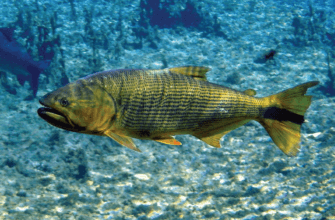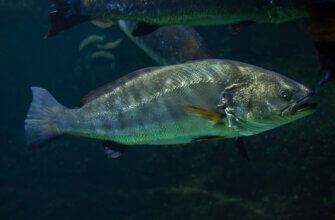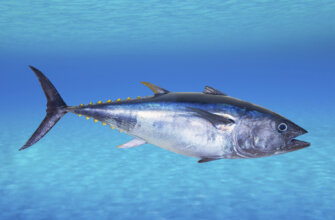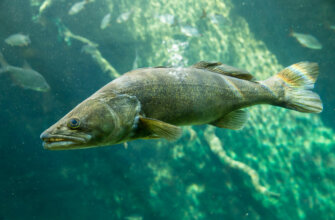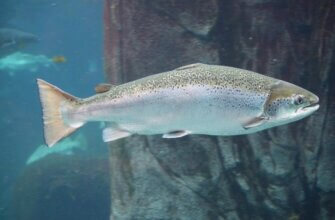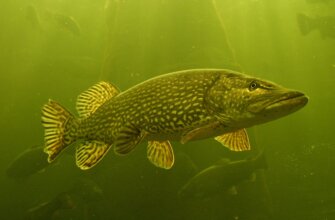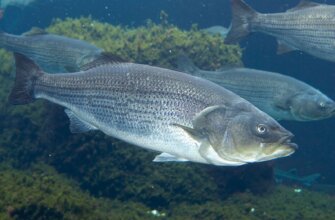Payara fish, also known as the vampire fish or saber-toothed tiger fish, is a species of predatory freshwater fish found in South America. It belongs to the family Cynodontidae and is scientifically known as Hydrolycus scomberoides. The name “payara” comes from the indigenous language Tupi-Guarani and means “serrated fish.”
Payara fish are known for their distinctive appearance and formidable teeth. They have elongated bodies, silver scales, and large eyes. However, their most striking feature is their long, fang-like teeth, which can grow up to six inches in length. These sharp teeth give them a fearsome appearance and aid them in capturing and consuming their prey.
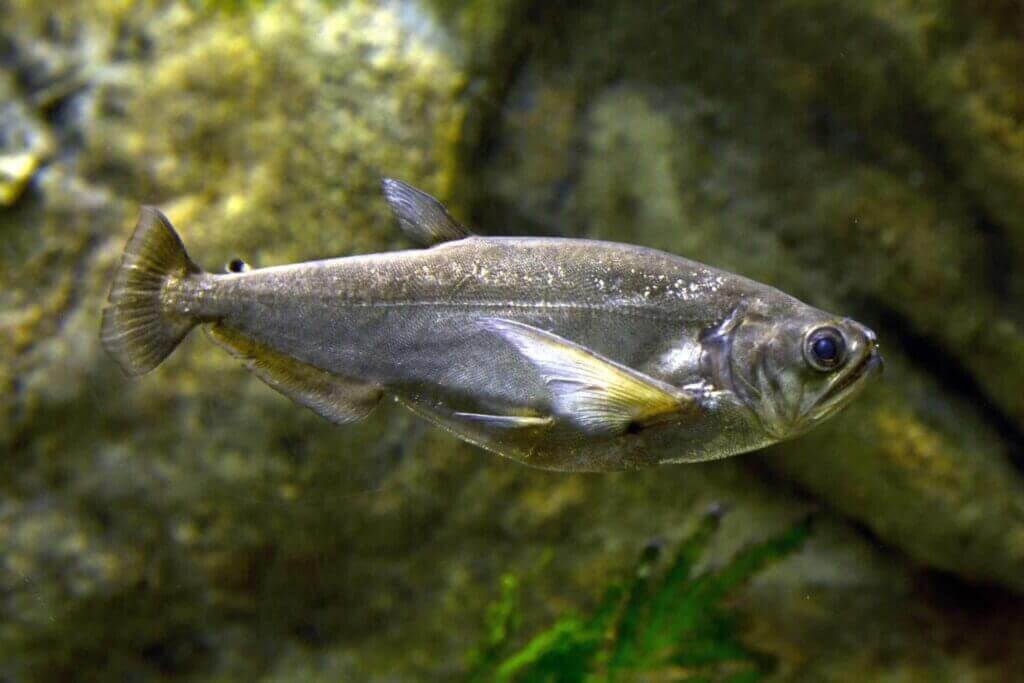
These fish are native to the Amazon River basin and can be found in various rivers and tributaries throughout South America, including the Orinoco River and the Essequibo River. They are primarily piscivorous, meaning they feed on other fish, using their sharp teeth to impale and immobilize their prey.
Payara fish are highly prized by anglers for their strength and fighting ability. They are considered a challenging and exciting species to catch. Due to their popularity, payara fishing has become a popular sport in certain regions where they are found.
It’s worth noting that payara fish are not typically kept as aquarium pets due to their large size and predatory nature. They require specialized conditions and a suitable tank setup to thrive, making them more suitable for experienced and dedicated aquarists.
Overall, the payara fish is an intriguing species known for its unique appearance and predatory behavior, making it a fascinating subject for anglers and fish enthusiasts alike.
Species
The term “payara” is commonly used to refer to two different species of fish: the Hydrolycus scomberoides and the Hydrolycus armatus.
Both species are predatory freshwater fish found in South America and share some similarities in appearance and behavior:
- Hydrolycus scomberoides (commonly known as Payara or Vampire Fish): This species is also referred to as the true payara. It is the more well-known species among the two and is often associated with the name “payara.” It has a slender, elongated body with silver scales and large eyes. The most distinctive feature of Hydrolycus scomberoides is its long, fang-like teeth that can reach impressive lengths. They are found in the Amazon River basin and its tributaries.
- Hydrolycus armatus (commonly known as Giant Payara): This species, sometimes referred to as the giant payara, is closely related to Hydrolycus scomberoides. It is similar in appearance but generally larger in size. Hydrolycus armatus can grow up to 4 feet in length and is known for its powerful and aggressive nature. They are found in various rivers and waterways in South America.
Both species of payara are highly prized by anglers for their strength, acrobatic fighting style, and challenging nature. They primarily feed on other fish, using their sharp teeth to impale and immobilize their prey.
It’s important to note that payara fish are not commonly kept as aquarium pets due to their large size, specialized care requirements, and predatory behavior. They are more commonly encountered in the wild or in specialized facilities where they are kept for research or conservation purposes.
Appearance
The payara, or vampire fish, has a distinctive and impressive appearance.
Here are some details about its appearance:
- Body Shape. Payara fish have a sleek and elongated body shape, similar to that of a torpedo. They have a streamlined profile that allows them to move swiftly through the water.
- Scales. Payara have silvery scales that reflect light, giving them a shiny appearance. The scales help protect their body and contribute to their overall sleek look.
- Head. One of the most distinctive features of the payara fish is its head. It has a large and powerful head with a slightly pointed snout. The head is equipped with large, sharp teeth, which are the main reason for the “vampire fish” nickname. The front two teeth in the lower jaw can grow to impressive lengths and resemble fangs. These teeth are used to catch and impale prey.
- Eyes. Payara fish have relatively large eyes, which are well-adapted for hunting in low-light conditions. This feature helps them locate prey and navigate their environment.
Overall, the payara fish has a sleek and powerful appearance, with its elongated body, silvery scales, and prominent fang-like teeth. Its unique and formidable appearance has made it a sought-after species among anglers and a subject of fascination for fish enthusiasts.
Size and weight
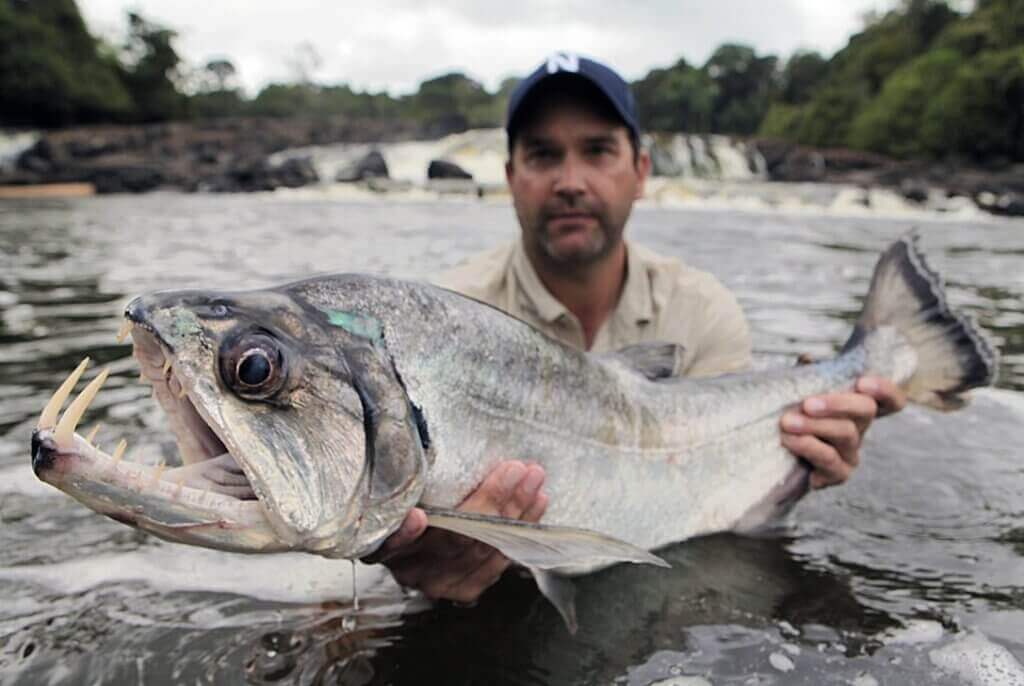
The size and weight of payara fish can vary depending on the species and individual specimens.
Here are some general guidelines regarding the size and weight of payara fish:
- Hydrolycus scomberoides (True Payara or Vampire Fish): This species typically reaches a maximum length of around 3 feet (90 cm) and can weigh up to approximately 40 pounds (18 kg). However, it’s worth noting that larger individuals have been reported, occasionally exceeding these average measurements.
- Hydrolycus armatus (Giant Payara): The giant payara is generally larger in size compared to the true payara. It can grow up to 4 feet (120 cm) in length and may weigh over 50 pounds (23 kg). Some exceptional individuals have been recorded at even larger sizes.
It’s important to keep in mind that these size and weight ranges are approximate and can vary based on factors such as habitat conditions, food availability, and individual genetics. Additionally, payara fish have the potential to grow rapidly during their early years.
When it comes to fishing for payara, landing a specimen that exceeds the average size can be a thrilling achievement for anglers. These fish are known for their strength and acrobatic fighting style, which adds to the excitement of pursuing them as a prized catch.
Diet
Payara fish are carnivorous predators and have a diet primarily consisting of other fish. Their sharp fang-like teeth are well-suited for capturing and impaling their prey.
Here are some key points about the diet of payara fish:
- Fish Predation. Payara predominantly feed on other fish species. They are skilled hunters and use their speed, agility, and sharp teeth to catch and consume their prey. Payara have a powerful bite force that enables them to immobilize and subdue their prey quickly.
- Piscivorous Behavior. Payara fish are piscivores, meaning they primarily eat other fish. They are known to hunt in schools and exhibit cooperative feeding behavior, where they work together to corral and ambush their prey. This cooperative hunting strategy allows them to take down larger fish and maximize their hunting success.
- Prey Selection. Payara fish show a preference for smaller fish species that inhabit the same waters. They commonly feed on various types of smaller fish found in their natural habitat, such as tetras, characins, cichlids, and other similar-sized species. The sharp teeth of payara enable them to impale and secure their prey, making it difficult for them to escape.
- Nocturnal Feeding. Payara fish are known to be most active during low-light conditions, particularly at dawn and dusk. They have excellent vision adapted for hunting in dimly lit environments, which gives them an advantage when pursuing prey during the early morning or late afternoon hours.
It’s important to note that payara fish are strictly carnivorous and do not consume plant matter or invertebrates as a significant part of their diet. Their feeding behavior is focused on capturing and consuming other fish species using their specialized teeth and predatory instincts.
Behavior
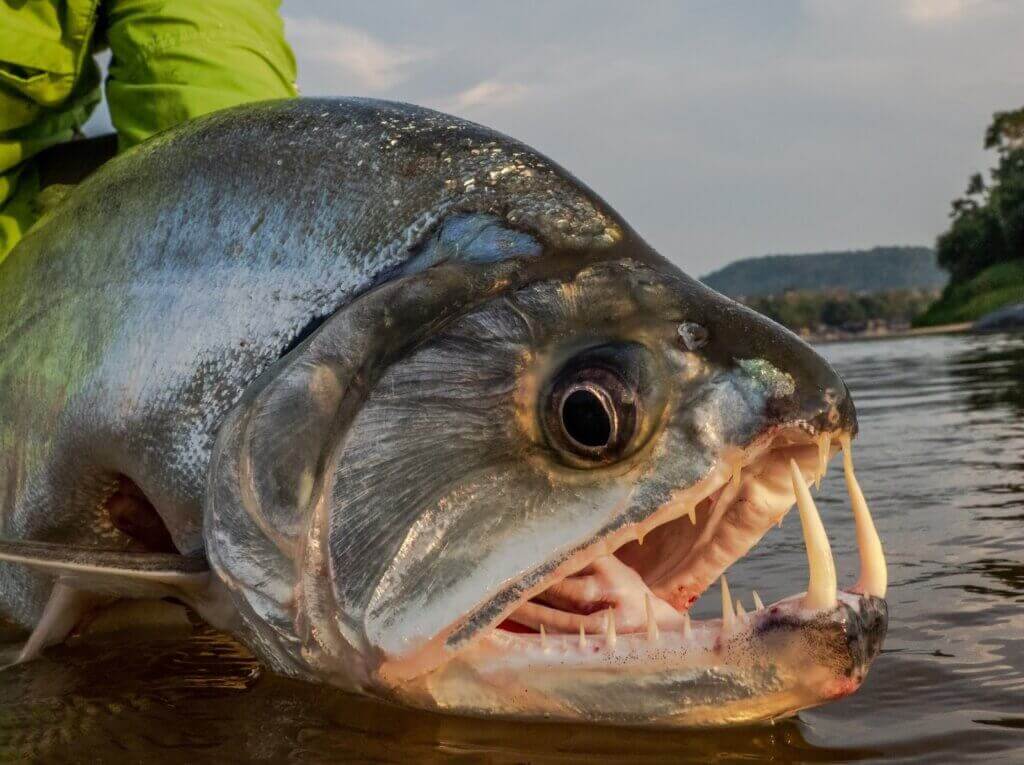
Payara fish exhibit several interesting behaviors that are characteristic of their predatory nature and adaptation to their freshwater habitat.
Here are some key behaviors commonly associated with payara:
- Aggressive Predation – payara are fierce and aggressive predators. They are known for their hunting prowess and their ability to swiftly capture and subdue their prey. They use their sharp fang-like teeth to impale and immobilize the fish they hunt.
- Cooperative Hunting – payara often engage in cooperative hunting behavior, particularly when pursuing larger prey. They form schools or groups and work together to corral and ambush their prey. This cooperative strategy allows them to take down larger fish more effectively.
- Nocturnal Activity – payara fish are primarily nocturnal, which means they are most active during the night and low-light conditions. They have well-developed sensory systems, including excellent low-light vision, which gives them an advantage in hunting during these times.
- Speed and Agility – payara are swift swimmers and possess exceptional agility. They have streamlined bodies and muscular tails that enable them to navigate their freshwater habitats with ease. This speed and agility aid them in chasing down and capturing their prey.
- Solitary Lifestyle – while payara can engage in cooperative hunting, they are generally solitary fish. They prefer to hunt and reside alone, seeking out their own territories within their freshwater habitats.
- Migratory Behavior: Some species of payara, such as the Hydrolycus armatus (giant payara), exhibit migratory behavior. They may move between different areas within their native river systems, often in search of suitable feeding grounds or spawning sites.
- Territorial Defense: Payara fish can be territorial and defend their preferred areas against intruders. They may display aggressive behavior towards other fish, especially during breeding seasons or when protecting their hunting grounds.
It’s important to note that payara fish are known for their fierce and predatory nature. These behaviors contribute to their reputation as formidable predators in their freshwater ecosystems.
Spawning
The spawning behavior of payara fish is not as well-documented as some other fish species.
However, based on available information, here are some general aspects of payara spawning:
- Breeding Season. Payara are believed to have a breeding season, during which they engage in reproductive activities. The exact timing of the breeding season may vary depending on the specific geographic region and environmental conditions. It is thought to occur during certain periods of the year when conditions are suitable for successful reproduction.
- Migratory Behavior. Some species of payara, such as the Hydrolycus armatus (giant payara), are known to exhibit migratory behavior related to spawning. They may undertake seasonal movements within their native river systems, possibly in search of suitable spawning grounds.
- Spawning Habitat. Payara are known to spawn in open water or near submerged vegetation. They typically require areas with suitable conditions, such as appropriate water temperature and quality, as well as adequate hiding places or structures where eggs can be deposited.
- Courtship and Reproduction. The specific courtship behavior of payara fish is not well-documented. However, it is believed that males and females engage in some form of courtship rituals or displays to attract mates and initiate spawning.
- Egg Deposition. Female payara release their eggs into the water, where they are fertilized by the males. The adhesive eggs stick to submerged vegetation or other structures in the spawning area. The number of eggs produced by female payara can be significant, with estimates ranging from a few hundred to several thousand.
- Parental Care. Payara are not known to provide parental care to their eggs or fry (baby fish). Once the eggs are laid, the parents do not guard or care for them. Instead, the eggs are left to develop on their own, relying on environmental factors for their survival.
Due to the limited scientific information available on payara spawning, more research is needed to fully understand the intricacies of their reproductive behavior. The specific details of their spawning behavior may vary among different species of payara and can be influenced by local environmental conditions.
Fishing

Fishing for payara can be an exciting and challenging experience due to their strength, acrobatic fighting style, and predatory nature.
Here are some tips and considerations for fishing payara:
- Location. Payara fish are native to the Amazon River basin and its tributaries, as well as other South American rivers. Research and identify areas known for having payara populations. Local guides or experienced anglers familiar with the region can provide valuable information on prime fishing spots.
- Fishing Gear. Use appropriate fishing gear suitable for targeting large and powerful fish. Medium to heavy spinning or baitcasting rods, with strong lines in the range of 30 to 50 pounds, are commonly used. Payara have strong jaws and sharp teeth, so it’s important to use steel leaders or heavy fluorocarbon leaders to prevent bite-offs.
- Bait and Lures. Payara are predatory fish, and their diet primarily consists of other fish. Effective bait options include live baitfish such as sardines, mullet, or shad. Dead baitfish can also be used, either whole or in chunks. Large, flashy lures resembling fish or streamers can be effective for attracting payara’s attention. Consider using lures with treble hooks and wire leaders for better hook penetration and durability.
- Presentation and Technique. Payara are often found in fast-moving waters, such as river channels, eddies, or areas with structure like submerged logs or rock formations. Cast your bait or lure into areas where payara are likely to hunt or seek shelter. Retrieve your bait or lure with a combination of steady reeling, twitching, or intermittent pauses to mimic the movements of injured prey and entice strikes.
- Timing and Conditions. Payara are generally more active during low-light conditions, such as dawn and dusk. Fishing during these times can increase your chances of success. Additionally, pay attention to water temperature, as payara tend to be more active in warmer waters.
- Safety. Payara are powerful fish, so exercise caution when landing and handling them. Use a landing net or gripper to secure the fish and avoid direct contact with their sharp teeth.
- Catch and Release. Payara are a valuable species, both ecologically and as a sport fish. Consider practicing catch and release to help conserve the population. Handle the fish with care, minimize handling time, and release them back into the water quickly to ensure their survival.
As with any fishing experience, it’s essential to familiarize yourself with local fishing regulations and obtain any necessary permits or licenses before engaging in payara fishing. Local fishing guides or experienced anglers can provide valuable insights and guidance specific to the region you plan to fish in.
Lures
When targeting payara, using the right lures can greatly increase your chances of success.
Here are some lure options that are commonly used for payara fishing:
- Swimbaits: Large, realistic swimbaits that resemble injured or fleeing fish can be effective for enticing payara. Opt for swimbaits in the 6 to 10-inch range with a lifelike swimming action. Choose lures with built-in rattles or internal weights to add extra attraction and mimic the sound of distressed prey.
- Topwater Lures: Payara are known for their explosive strikes, and topwater lures can elicit thrilling surface strikes. Use large-sized prop baits, poppers, or walk-the-dog style lures that create a commotion on the water’s surface. Payara often strike from below, so choose lures that can stay in the strike zone longer.
- Jerkbaits: Long, slender jerkbaits with a realistic baitfish profile can be effective for imitating the swimming action of injured prey. Choose jerkbaits in the 6 to 10-inch range and experiment with different colors and patterns to match the forage in the area.
- Lipless Crankbaits: Vibrating lipless crankbaits can be effective for covering water and attracting the attention of payara. Choose lures in the 3 to 4-inch range with a tight wobbling action and a loud rattling sound. Cast and retrieve the lure at different speeds to find the optimal presentation.
- Streamer Flies: If fly fishing for payara, large streamer flies can be highly effective. Use patterns that imitate injured baitfish, such as Clouser Minnows, Deceiver patterns, or articulated streamers. Payara are known to aggressively strike flies, so make sure your gear is appropriately sized and strong enough to handle these powerful fish.
When selecting lures for payara fishing, consider choosing lures with sturdy hooks, as payara have strong jaws and sharp teeth that can put significant strain on tackle. Additionally, opt for lures with wire leaders or attach a heavy fluorocarbon leader to prevent bite-offs.
It’s important to vary your retrieves, experiment with different lure colors and sizes, and adapt to the specific conditions and preferences of the payara in your fishing location. Payara are known for their unpredictability, so being versatile with your lure selection and presentation can increase your chances of enticing a strike.
Here are a few examples of fishing lures that have been used successfully for targeting payara.
Please note that specific models and specifications may vary, and it’s always a good idea to consult with local anglers or fishing guides for the most up-to-date and region-specific recommendations:
- Yo-Zuri Crystal Minnow: This lure is a popular choice for payara fishing due to its lifelike appearance and enticing swimming action. The 6 3/4-inch (17 cm) floating model, such as the Yo-Zuri Crystal Minnow F1154, can be effective. It features a durable, translucent body with holographic inserts and a tight wiggling action.
- Rapala X-Rap: The Rapala X-Rap series offers several models suitable for payara fishing. The X-Rap XR10 or XR12 can be effective choices. These suspending jerkbaits measure around 4 inches (10 cm) and 4 3/4 inches (12 cm), respectively. They have a realistic profile, internal rattles, and a responsive darting action that can trigger strikes.
- Sebile Stick Shadd: The Sebile Stick Shadd is a versatile lure that works well for payara. The 155mm sinking model can be a good choice. It measures around 6 inches (15.5 cm) and features a slender profile with lifelike finishes, internal weights, and a tight swimming action that imitates injured baitfish.
- Savage Gear 3D Rat: The Savage Gear 3D Rat is a topwater lure that can entice explosive strikes from payara. The 7 3/4-inch (20 cm) floating model, such as the Savage Gear 3D Rat 200, is suitable. It has a realistic rat-shaped body with treble hooks, a jointed tail, and a walking-the-dog action that creates commotion on the surface.
- Clouser Minnow Fly: When fly fishing for payara, the Clouser Minnow is a classic and effective pattern. This fly imitates baitfish and can be tied in various sizes and color combinations. It typically consists of weighted eyes, a bucktail or synthetic hair body, and flash materials. Sizes ranging from 2/0 to 4/0 can be suitable for payara.
These are just a few examples of lures that have proven successful for payara fishing. Remember to adjust your lure selection based on the specific conditions, location, and preferences of the payara you are targeting.
Baits
When targeting payara, using the right baits can greatly increase your chances of enticing a strike.
Here are some effective bait options for payara fishing:
- Live Baitfish: Live baitfish are highly effective for targeting payara. Sardines, shad, mullet, or similar-sized baitfish can be used. Hook the baitfish through the lips or back to allow it to swim naturally. Use a strong hook and attach a wire leader to prevent bite-offs from the payara’s sharp teeth.
- Dead Baitfish: Dead baitfish can also be productive for payara. Use whole or cut baitfish such as sardines, mullet, or shad. You can allow the bait to drift naturally in the current or suspend it at varying depths using a weighted rig.
- Cut Bait: Cut bait is another effective option for payara. Use chunks or strips of baitfish, such as sardines or mullet. You can thread the bait onto a single or treble hook and present it near structure or in areas where payara are likely to be feeding.
- Poppers: Popper lures that create splashes and commotion on the water’s surface can be effective for enticing payara. They imitate a struggling or injured prey fish. Cast the popper near likely payara holding areas and use a popping or “walk-the-dog” retrieve to trigger strikes.
- Streamer Flies: If fly fishing for payara, large streamer flies that imitate injured baitfish can be highly effective. Use patterns such as Clouser Minnows, Deceiver patterns, or articulated streamers in colors that match the local baitfish. Ensure that your fly is appropriately sized and tied on a strong hook to handle the power of payara.
- Soft Plastic Swimbaits: Soft plastic swimbaits with a lifelike swimming action can be productive for payara. Choose swimbaits in the 6 to 10-inch range that mimic the profile and movement of injured prey fish. Rig them on a weighted hook or jighead and retrieve them with a steady, swimming action.
When using bait for payara fishing, it’s essential to consider the local regulations and restrictions regarding the use of live bait or specific baitfish species. Also, ensure that your gear is appropriately sized and strong enough to handle the powerful strikes and fighting ability of payara.
When targeting payara, using the right baits can greatly increase your chances of success. Here are a few examples of fishing baits that have been used successfully for payara fishing:
- Sardines: Fresh or frozen sardines are a popular bait choice for payara fishing. You can use them whole or cut them into chunks or strips. Hook the sardine through the lips or thread it onto a single or treble hook. The size of the sardines will depend on the average size of the baitfish in the area you are fishing.
- Mullet: Mullet is another effective bait for payara. Use fresh or frozen mullet and cut them into chunks or strips. Hook the mullet through the lips or thread it onto a single or treble hook. Adjust the size of the mullet chunks based on the average size of the baitfish in the area.
- Shad: Shad is a common baitfish that payara feed on, so using fresh or frozen shad can be productive. Cut the shad into chunks or strips and present them on a single or treble hook. Adjust the size of the shad chunks based on the average size of the baitfish in the area.
- Herring: Herring is another baitfish that can entice strikes from payara. Use fresh or frozen herring and cut them into chunks or strips. Hook the herring through the lips or thread it onto a single or treble hook. Adjust the size of the herring chunks based on the average size of the baitfish in the area.
- Chicken Hearts: In some regions, chicken hearts have been found to be an effective bait for payara. They can be used whole or cut into smaller pieces. Chicken hearts can be tough and stay on the hook well, making them a durable option for fishing.
- Peacock Bass Flies: Peacock bass flies, such as large streamers, can be effective for payara fishing. These flies imitate baitfish and can be tied in various colors and sizes. Choose patterns that have a realistic appearance and use strong hooks to handle the powerful strikes of payara.
Remember that bait preferences may vary depending on the specific location and the forage available to payara in that area. It’s always a good idea to consult with local anglers or fishing guides for the most effective bait options for payara fishing in your specific region.
Rods
When fishing for payara, it’s important to use a fishing rod that can handle the power and strength of these predatory fish.
Here are some details to consider when selecting a fishing rod for payara:
- Rod Power: Payara are powerful fish that can put up a strong fight. It’s recommended to use a medium-heavy to heavy power rod. This will provide the backbone and strength needed to handle the weight and resistance of payara during the fight.
- Rod Length: The length of the rod depends on the fishing technique and the fishing environment. For general payara fishing, a rod length between 7 to 9 feet is commonly used. Longer rods can provide greater casting distance and leverage during the fight, while shorter rods offer more maneuverability in tight spaces.
- Rod Action: The action of the rod determines how it bends and responds to the fish’s movements. For payara fishing, a fast or extra-fast action rod is preferred. These rods have a quick and sensitive tip that allows for better hook sets and control over the fish during the fight.
- Rod Material: Graphite or composite rods are commonly used for payara fishing. These materials offer a good balance between strength, sensitivity, and weight. They provide the necessary backbone to handle powerful strikes and intense fights while remaining lightweight and responsive.
- Rod Guides: Payara fishing rods should be equipped with sturdy and corrosion-resistant rod guides. Ceramic or stainless steel guides are commonly used, as they can withstand the strain of heavy lines and resist damage from the payara’s sharp teeth.
- Rod Handle: Choose a rod with a comfortable and ergonomic handle. Common handle materials include cork and EVA foam. Pay attention to the handle length and grip design, as they can affect casting accuracy, control, and overall comfort during long fishing sessions.
- Line Rating: Payara fishing rods should have a line rating suitable for the fishing technique and the targeted size of payara. Typically, a line rating of 20 to 50 pounds is recommended, depending on the size and strength of the payara in the fishing location.
When selecting a payara fishing rod, it’s important to consider the specific fishing conditions, target size of payara, and personal preferences. It’s always a good idea to consult with local anglers or fishing tackle shops for specific rod recommendations tailored to the payara fishing in your area.
Here are a few examples of fishing rods that are commonly used for payara fishing. Please note that specific models and specifications may vary, and it’s important to choose a rod that suits your fishing style, preferences, and the specific conditions of your fishing location:
- St. Croix Mojo Inshore Casting Rod: This rod is designed for inshore fishing, but it can also be suitable for targeting payara. The Mojo Inshore series offers models with medium-heavy to heavy power ratings and lengths ranging from 7 to 8 feet. These rods are constructed with high-modulus SCIII graphite, feature quality components, and have a fast action for sensitivity and strong hook sets.
- Shimano Teramar Southeast Casting Rod: The Shimano Teramar Southeast series includes rods specifically designed for fishing in Southeastern US waters, where payara can be found. These rods are available in medium-heavy to heavy power ratings and lengths between 7 to 8 feet. They are built with a lightweight and responsive TC4 construction and feature Fuji Alconite guides for smooth line flow.
- Okuma Cedros CJ-65S Spinning Rod: The Okuma Cedros CJ-65S spinning rod is a heavy-duty option suitable for targeting large payara. It has a length of 6.5 feet and a heavy power rating. This rod is designed to handle big fish and features a durable E-glass blank construction, Fuji guides, and a comfortable EVA handle for extended fishing sessions.
- Penn Rampage Boat Casting Rod: If you’re planning to fish for payara from a boat, the Penn Rampage Boat casting rod can be a good choice. It comes in various models with lengths between 6 to 7.5 feet and heavy power ratings. These rods are built with a lightweight and strong graphite composite blank, stainless steel guides with aluminum oxide inserts, and have a fast action for sensitivity and quick hook sets.
- G. Loomis E6X Inshore Casting Rod: The G. Loomis E6X Inshore series offers casting rods specifically designed for inshore saltwater fishing, which can also be suitable for payara fishing. These rods come in various lengths and power ratings, ranging from medium-heavy to heavy. They are constructed with a lightweight and sensitive E6X graphite blank and feature quality Fuji guides and a comfortable cork handle.
These are just a few examples of fishing rods that have been used successfully for payara fishing. Remember to choose a rod that matches your fishing technique, target size of payara, and the specific conditions of your fishing location. It’s always recommended to visit local fishing tackle shops or consult with experienced anglers in your area for personalized recommendations based on your specific needs.
Dishes
Traira is a popular freshwater fish found in South America, particularly in Brazil. It is known for its aggressive nature and delicious meat. Traira dishes are enjoyed by many people in the region.
Here are a few popular traíra dishes with some details:
- Traira Frita (Fried Traira). This is a simple and classic way to prepare traíra. The fish is typically cleaned, seasoned with salt, pepper, and lime juice, and then deep-fried until golden and crispy. It is often served with a side of rice, beans, and a fresh salad.
- Moqueca de Traira (Traira Fish Stew). Moqueca is a traditional Brazilian dish that can be made with different types of fish, including traíra. In this preparation, the traíra is marinated in a mixture of lime juice, garlic, and spices, then cooked in a flavorful broth made with coconut milk, tomatoes, onions, peppers, and herbs. It is typically served with rice and farofa (toasted cassava flour).
- Escabeche de Traira (Pickled Traira). In this dish, the traíra is first cooked by boiling or frying until tender. It is then marinated in a mixture of vinegar, olive oil, onions, garlic, peppers, and various herbs and spices. The pickling process gives the fish a tangy and flavorful taste. It can be served as an appetizer or as part of a larger meal.
- Traira Assada (Grilled Traira). Grilling traíra is another popular way to prepare this fish. The traíra is typically cleaned, seasoned with spices or a marinade, and then grilled until cooked through. It can be served with a side of roasted vegetables, potatoes, or a fresh salad.
- Acarajé de Traira. Acarajé is a traditional street food from the northeastern region of Brazil. It consists of deep-fried balls of black-eyed pea dough stuffed with various fillings. In some regions, traíra is used as a filling for acarajé, along with other ingredients such as shrimp, vatapá (a spicy paste made with shrimp, peanuts, and other ingredients), and salad.
These are just a few examples of traíra dishes commonly enjoyed in South America, particularly in Brazil. The specific preparations and seasonings can vary based on regional preferences and personal tastes. If you have the opportunity to try traíra, I recommend sampling it in a local restaurant or from a trusted cook who specializes in regional cuisine for an authentic and delicious experience.

